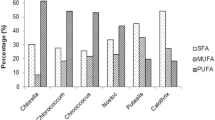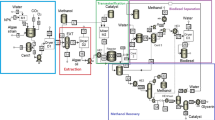Abstract
Sustainable fuel production techniques and feedstocks are essential to meet the future energy demand. In this context, the present study is aimed at sustainably producing low-density biodiesel from Chlorella pyrenoidosa microalgae by heterotrophic means and processed using enzymatic transesterification. To assess the potential of the low-density biodiesel, the fatty acid methyl profile is analyzed and homogenized with diesel fuel at 10, 20, 30, and 40% (v/v/) and tested in a light commercial compression ignition engine at maximum throttle pedal position condition. Furthermore, to identify the optimal mixture proportion and predict the engine outputs, statistical tools like multivariate principal component analysis–desirability approach are employed. From the study, it was inferred that the biomass concentrations of the cultures from 100, 200, and 300L stir tank bioreactor reached up to 5.15, 4.24, and 4.36 g/L on scaling-up. The maximum biodiesel conversion rate of 98% was achieved at an optimal reaction time of 12 h and temperature of 37 °C during enzymatic transesterification. During engine testing, the lowest fuel consumption of 0.41 kg/kWh was attained at full load condition while operating on 40% biodiesel composition. At 20% biodiesel composition, hydrocarbon, nitrogen oxides, and smoke emissions reduce by 44.26, 23.55, and 11.69% as compared to diesel fuel at full load condition. Maximum in-cylinder pressure and heat release rate were achieved by CP30D70 at full load condition as compared to diesel fuel. The optimal biodiesel proportion was identified as 20 and 30% based on the cluster similarly index of 89.67% and desirability value.










Similar content being viewed by others
References
Chun Ng, C. W., Ismail, A. F., Zaini Makhtar, M. M., Fikri Jamaluddin, M. N., & Tajarudin, H. A. (2020). Conversion of food waste via two-stage fermentation to controllable chicken Feed Nutrients by local isolated microorganism. International journal of recycling organic waste in agriculture, 9(1), 33–47. https://doi.org/10.30486/IJROWA.2020.671208
Deepanraj, B., Srinivas, M., Arun, N., Sankaranarayanan, G., & Abdul, S. P. (2017). Comparison of jatropha and karanja biofuels on their combustion characteristics. International Journal of Green Energy., 14(15), 1231–1237.
Ghidossi, T., Marison, I., Devery, R., Gaffney, D., & Forde, C. (2017). Characterization and optimization of a fermentation process for the production of high cell densities and lipids using heterotrophic cultivation of chlorella protothecoides. Industrial Biotechnology., 13(5), 253–259. https://doi.org/10.1089/ind.2017.0007
Gill, A. R., Viswanathan, K. K., & Hassan, S. (2018). A test of environmental Kuznets curve (EKC) for carbon emission and potential of renewable energy to reduce green house gases (GHG) in Malaysia. Environment, Development and Sustainability., 20(3), 1103–1114.
Islam, M. A., Rahman, M. M., Heimann, K., Nabi, M. N., Ristovski, Z. D., Dowell, A., Thomas, G., Feng, B., Von Alvensleben, N., & Brown, R. J. (2015). Combustion analysis of microalgae methyl ester in a common rail direct injection diesel engine. Fuel, 1(143), 351–360.
Jabbr, A. I., Gaja, H., & Koylu, U. O. (2020). Multi-objective optimization of operating parameters for a H2/Diesel dual-fuel compression-ignition engine. International Journal of Hydrogen Energy., 45(38), 19965–19975.
Jacob, A., Ashok, B., Alagumalai, A., Chyuan, O. H., & Le, P. T. (2020). Critical review on third generation micro algae biodiesel production and its feasibility as future bioenergy for IC engine applications. Energy Conversion and Management., 20, 113655. https://doi.org/10.1016/j.enconman.2020.113655
John, C. B., Solamalai, A. R., Jambulingam, R., & Balakrishnan, D. (2020). Estimation of fuel properties and characterization of hemp biodiesel using spectrometric techniques. Energy Sources, Part a: Recovery, Utilization, and Environmental Effects., 2, 1–8.
Kale, B. N., Patle, S. D., & Kalambe, S. R. (2021). Microalgae biodiesel and its various diesel blends as promising alternative fuel for diesel engine. Materials Today: Proceedings., 1(44), 2972–2977.
Katiyar, R., Gurjar, B. R., Bharti, R. K., Kumar, A., Biswas, S., & Pruthi, V. (2017). Heterotrophic cultivation of microalgae in photobioreactor using low cost crude glycerol for enhanced biodiesel production. Renewable Energy, 1(113), 1359–1365.
Koç, E., Çelik-Uzuner, S., Uzuner, U., & Çakmak, R. (2018). The detailed comparison of cell death detected by annexin V-PI counterstain using fluorescence microscope, flow cytometry and automated cell counter in mammalian and microalgae cells. Journal of Fluorescence., 28(6), 1393–1404. https://doi.org/10.1007/s10895-018-2306-4
Krishnamoorthy, N., Unpaprom, Y., Ramaraj, R., Maniam, G. P., Govindan, N., Arunachalam, T., & Paramasivan, B. (2021). Recent advances and future prospects of electrochemical processes for microalgae harvesting. Journal of Environmental Chemical Engineering, 15, 105875.
Liu J, Sun Z, Gerken H (2014) Recent advances in microalgal biotechnology. Potential applications of microalgae in wastewater treatments. Published by OMICS Group eBooks, USA, Chapter
Moazeni, F., Chen, Y. C., & Zhang, G. (2019). Enzymatic transesterification for biodiesel production from used cooking oil, a review. Journal of Cleaner Production., 10(216), 117–128. https://doi.org/10.1016/j.jclepro.2019.01.181
Mohan, S. V., Rohit, M. V., Chiranjeevi, P., Chandra, R., & Navaneeth, B. (2015). Heterotrophic microalgae cultivation to synergize biodiesel production with waste remediation: Progress and perspectives. Bioresource Technology., 1(184), 169–178.
Morales-Sánchez, D., Martinez-Rodriguez, O. A., & Martinez, A. (2017). Heterotrophic cultivation of microalgae: Production of metabolites of commercial interest. Journal of Chemical Technology & Biotechnology., 92(5), 925–936.
Mustapa, M., Sallehudin, N. J., Mohamed, M. S., Noor, N. M., & Raus, R. A. (2016). Decontamination of Chlorella sp. culture using antibiotics and antifungal cocktail treatment. ARPN J Eng Appl Sci, 11, 104–109.
Nagappan, S., Devendran, S., Tsai, P. C., Dahms, H. U., & Ponnusamy, V. K. (2019). Potential of two-stage cultivation in microalgae biofuel production. Fuel, 15(252), 339–349.
Nazari, M. T., Mazutti, J., Basso, L. G., Colla, L. M., & Brandli, L. (2020). Biofuels and their connections with the sustainable development goals: A bibliometric and systematic review. Environment, Development and Sustainability., 24, 1–8.
El Ouaer, M., Turki, N., Kallel, A., Halaoui, M., Trabelsi, I., & Hassen, A. (2020). Recovery of landfill leachate as culture medium for two microalgae: Chlorella sp and Scenedesmus sp. Environment, Development and Sustainability, 22(3), 2651–2671.
Pleissner, D., Lau, K. Y., & Lin, C. S. (2017). Utilization of food waste in continuous flow cultures of the heterotrophic microalga Chlorella pyrenoidosa for saturated and unsaturated fatty acids production. Journal of Cleaner Production., 20(142), 1417–1424. https://doi.org/10.1016/j.jclepro.2016.11.165
Rajak, U., Nashine, P., & Verma, T. N. (2020). Effect of spirulina microalgae biodiesel enriched with diesel fuel on performance and emission characteristics of CI engine. Fuel, 268, 117305.
Raman, L. A., Deepanraj, B., Rajakumar, S., & Sivasubramanian, V. (2019). Experimental investigation on performance, combustion and emission analysis of a direct injection diesel engine fuelled with rapeseed oil biodiesel. Fuel, 15(246), 69–74.
Saengsawang, B., Bhuyar, P., Manmai, N., Ponnusamy, V. K., Ramaraj, R., & Unpaprom, Y. (2020). The optimization of oil extraction from macroalgae Rhizoclonium sp by chemical methods for efficient conversion into biodiesel. Fuel, 274, 117841.
Sharma, M. P. (2016). Selection of potential oils for biodiesel production. Renewable and Sustainable Energy Reviews., 1(56), 1129–1138.
Shobana R, Vijayalakshmi S, Deepanraj B, Ranjitha J (2021) Biodiesel production from Capparis spinosa L seed oil using calcium oxide as a heterogeneous catalyst derived from oyster shell. Materials Today: Proceedings.
Subramaniam, M., Solomon, J. M., Nadanakumar, V., Anaimuthu, S., & Sathyamurthy, R. (2020). Experimental investigation on performance, combustion and emission characteristics of DI diesel engine using algae as a biodiesel. Energy Reports., 1(6), 1382–1392.
Tsai, D. D., Chen, P. H., & Ramaraj, R. (2017). The potential of carbon dioxide capture and sequestration with algae. Ecological Engineering., 1(98), 17–23.
Acknowledgements
Authors wish to thank Department of Science Technology (DST), India for funding this work under the scheme of ASEAN-India Science & Technology Development Fund (AISTDF) for the project (CDR/2018/ 000061).
Funding
Authors wish to thank Department of Science Technology (DST), India for funding of this work under the scheme of ASEAN-India Science & Technology Development Fund (AISTDF) for the project (CDR/2018/ 000061).
Author information
Authors and Affiliations
Contributions
Ashwin Jacob involved in conceptualization; Ashwin Jacob took part in formal analysis and investigation; Ashwin Jacob and B. Ashok involved in writing—original draft preparation; Ashwin Jacob and B. Ashok took part in writing—review and editing; B. Ashok, Hwai Chyuan Ong, Phung Thi Kim Le involved in Funding acquisition; B. Ashok, Hwai Chyuan Ong, Phung Thi Kim Le took part in supervision.
Corresponding author
Ethics declarations
Conflict of interest
The authors declare that they have no known competing financial interests or personal relationships that could have appeared to influence the work reported in this paper.
Additional information
Publisher's Note
Springer Nature remains neutral with regard to jurisdictional claims in published maps and institutional affiliations.
Rights and permissions
About this article
Cite this article
Jacob, A., Ashok, B., Ong, H.C. et al. Scaling-up heterotrophic cultures of C. Pyrenoidosa microalgae for sustainable synthesis of low-density biodiesel mixtures and predict CI engine behavior at optimal proportions. Environ Dev Sustain 25, 400–422 (2023). https://doi.org/10.1007/s10668-021-02060-1
Received:
Accepted:
Published:
Issue Date:
DOI: https://doi.org/10.1007/s10668-021-02060-1




